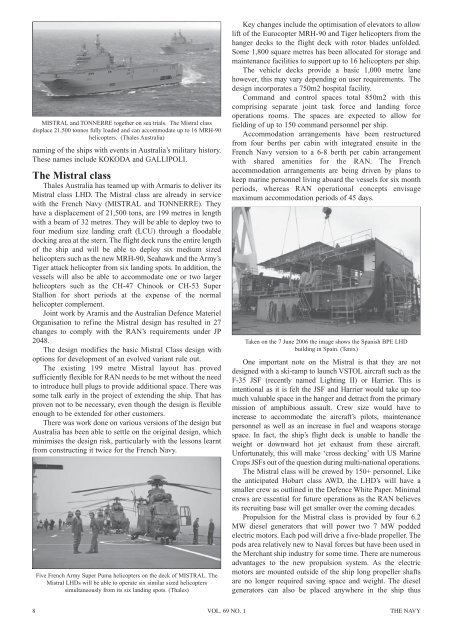Create successful ePaper yourself
Turn your PDF publications into a flip-book with our unique Google optimized e-Paper software.
MISTRAL and TONNERRE together on sea trials. The Mistral class<br />
displace 21,500 tonnes fully loaded and can accommodate up to 16 MRH-90<br />
helicopters. (Thales <strong>Australia</strong>)<br />
naming <strong>of</strong> the ships with events in <strong>Australia</strong>’s military history.<br />
These names include KOKODA and GALLIPOLI.<br />
The Mistral class<br />
Thales <strong>Australia</strong> has teamed up with Armaris to deliver its<br />
Mistral class LHD. The Mistral class are already in service<br />
with the French <strong>Navy</strong> (MISTRAL and TONNERRE). They<br />
have a displacement <strong>of</strong> 21,500 tons, are 199 metres in length<br />
with a beam <strong>of</strong> 32 metres. They will be able to deploy two to<br />
four medium size landing craft (LCU) through a floodable<br />
docking area at the stern. The flight deck runs the entire length<br />
<strong>of</strong> the ship and will be able to deploy six medium sized<br />
helicopters such as the new MRH-90, Seahawk and the Army’s<br />
Tiger attack helicopter from six landing spots. In addition, the<br />
vessels will also be able to accommodate one or two larger<br />
helicopters such as the CH-47 Chinook or CH-53 Super<br />
Stallion for short periods at the expense <strong>of</strong> the normal<br />
helicopter complement.<br />
Joint work by Aramis and the <strong>Australia</strong>n Defence Materiel<br />
Organisation to refine the Mistral design has resulted in 27<br />
changes to comply with the RAN’s requirements under JP<br />
2048.<br />
The design modifies the basic Mistral Class design with<br />
options for development <strong>of</strong> an evolved variant rule out.<br />
The existing 199 metre Mistral layout has proved<br />
sufficiently flexible for RAN needs to be met without the need<br />
to introduce hull plugs to provide additional space. There was<br />
some talk early in the project <strong>of</strong> extending the ship. That has<br />
proven not to be necessary, even though the design is flexible<br />
enough to be extended for other customers.<br />
There was work done on various versions <strong>of</strong> the design but<br />
<strong>Australia</strong> has been able to settle on the original design, which<br />
minimises the design risk, particularly with the lessons learnt<br />
from constructing it twice for the French <strong>Navy</strong>.<br />
Five French Army Super Puma helicopters on the deck <strong>of</strong> MISTRAL. The<br />
Mistral LHDs will be able to operate six similar sized helicopters<br />
simultaneously from its six landing spots. (Thales)<br />
Key changes include the optimisation <strong>of</strong> elevators to allow<br />
lift <strong>of</strong> the Eurocopter MRH-90 and Tiger helicopters from the<br />
hanger decks to the flight deck with rotor blades unfolded.<br />
Some 1,800 square metres has been allocated for storage and<br />
maintenance facilities to support up to 16 helicopters per ship.<br />
The vehicle decks provide a basic 1,000 metre lane<br />
however, this may vary depending on user requirements. The<br />
design incorporates a 750m2 hospital facility.<br />
Command and control spaces total 850m2 with this<br />
comprising separate joint task force and landing force<br />
operations rooms. The spaces are expected to allow for<br />
fielding <strong>of</strong> up to 150 command personnel per ship.<br />
Accommodation arrangements have been restructured<br />
from four berths per cabin with integrated ensuite in the<br />
French <strong>Navy</strong> version to a 6-8 berth per cabin arrangement<br />
with shared amenities for the RAN. The French<br />
accommodation arrangements are being driven by plans to<br />
keep marine personnel living aboard the vessels for six month<br />
periods, whereas RAN operational concepts envisage<br />
maximum accommodation periods <strong>of</strong> 45 days.<br />
Taken on the 7 June 2006 the image shows the Spanish BPE LHD<br />
building in Spain. (Tenix)<br />
One important note on the Mistral is that they are not<br />
designed with a ski-ramp to launch VSTOL aircraft such as the<br />
F-35 JSF (recently named Lighting II) or Harrier. This is<br />
intentional as it is felt the JSF and Harrier would take up too<br />
much valuable space in the hanger and detract from the primary<br />
mission <strong>of</strong> amphibious assault. Crew size would have to<br />
increase to accommodate the aircraft’s pilots, maintenance<br />
personnel as well as an increase in fuel and weapons storage<br />
space. In fact, the ship’s flight deck is unable to handle the<br />
weight or downward hot jet exhaust from these aircraft.<br />
Unfortunately, this will make ‘cross decking’ with US Marine<br />
Crops JSFs out <strong>of</strong> the question during multi-national operations.<br />
The Mistral class will be crewed by 150+ personnel. Like<br />
the anticipated Hobart class AWD, the LHD’s will have a<br />
smaller crew as outlined in the Defence White Paper. Minimal<br />
crews are essential for future operations as the RAN believes<br />
its recruiting base will get smaller over the coming decades.<br />
Propulsion for the Mistral class is provided by four 6.2<br />
MW diesel generators that will power two 7 MW podded<br />
electric motors. Each pod will drive a five-blade propeller. The<br />
pods area relatively new to Naval forces but have been used in<br />
the Merchant ship industry for some time. There are numerous<br />
advantages to the new propulsion system. As the electric<br />
motors are mounted outside <strong>of</strong> the ship long propeller shafts<br />
are no longer required saving space and weight. The diesel<br />
generators can also be placed anywhere in the ship thus<br />
8 VOL. 69 NO. 1 THE NAVY

















